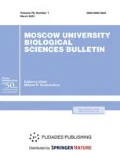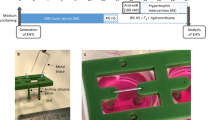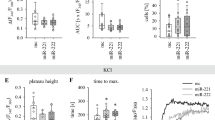Abstract
MicroRNA is a small, single-stranded nucleotide sequence, which can regulate gene expression at the posttranscriptional level. To date, it is known that some microRNAs play an important role in physiology and pathophysiology of the cardio-vascular system. The effects of lipotransfection with microRNAs, such as miR-1-3p, miR-153-3p, or miR-133-3p, on the electrophysiological indices of the myocardium tissue were studied here for the first time. With the use of the standard microelectrode technique, action potentials (AP) in isolated perfused samples of the rat atrial tissue were recorded after their treatment with a transfection mixture of a liposome forming reagent and miR-1-3p, miR-153-3p, or miR-133-3p. It is demonstrated that the treatment of the myocardial tissue with a transfection agent results in the prolongation of the repolarization phase of AP. It was found that miR-1-3p and miR-153-3p did not affect the pattern of AP within 6 h after the treatment of tissue samples. However, miR133a-3p evoked a statistically significant increase in the AP duration under 90% repolarization. The duration was maximum 4 h after the transfection. Search and analysis of possible targets for miR133a-3p using bioinformatic methods were performed and it was assumed that this microRNA can interact with mRNA of some protein phosphatases. Suppression of protein phosphatases’ expression in cardiomyocytes may underlie the increased AP duration during the application of miR133a-3p found in the present study due to the effect on the proteins of calcium turnover.


Similar content being viewed by others
REFERENCES
Romaine, S.P.R., Tomaszewski, M., Condorelli, G., and Samani, N.J., MicroRNAs in cardiovascular disease: An introduction for clinicians, Heart, 2015, vol. 101, no. 12, pp. 921–928.
D’Souza, A., Pearman, C.M., Wang, Y., et al., Targeting miR-423-5p reverses exercise training-induced hcn4 channel remodeling and sinus bradycardia, Circ. Res., 2017, vol. 121, no. 9, pp. 1058–1068.
Yan, B., Wang, H., Tan, Y., and Fu, W., MicroRNAs in cardiovascular disease: Small molecules but big roles, Curr. Top. Med. Chem., 2019, vol. 19, no. 21, pp. 1918–1947.
Koroleva, I.A., Nazarenko, M.S., and Kucher, A.N., Role of microRNA in development of instability of atherosclerotic plaques, Biochemistry, 2017, vol. 82, no. 11, pp. 1380–1390.
Kucher, A.N. and Nazarenko, M.S., The role of micro-RNA in atherogenesis, Kardiologiya, 2017, vol. 57, no. 9, pp. 65–76.
Baulina, N., Osmak, G., Kiselev, I., Matveeva, N., Kukava, N., Shakhnovich, R., Kulakova, O., and Favorova, O., NGS-identified circulating miR-375 as a potential regulating component of myocardial infarction associated network, J. Mol. Cell. Cardiol., 2018, vol. 121, pp. 173–179.
Cheng, W.L., Kao, Y.H., Chao, T.F., Lin, Y.K., Chen, S.A., and Chen, Y.J., MicroRNA-133 suppresses ZFHX3-dependent atrial remodelling and arrhythmia, Acta Physiol., 2019, vol. 227, no. 3.
Girmatsion, Z., Biliczki, P., Bonauer, A., Wimmer-Greinecker, G., Scherer, M., Moritz, A., Bukowska, A., Goette, A., Nattel, S., Hohnloser, S.H., and Ehrlich, J.R., Changes in microRNA-1 expression and IK1 up-regulation in human atrial fibrillation, Heart Rhythm, 2009, vol. 6, no. 12, pp. 1802–1809.
Terentyev, D., Belevych, A.E., Terentyeva, R., Martin, M.M., Malana, G.E., Kuhn, D.E., Abdellatif, M., Feldman, D.S., Elton, T.S., and Györke, S., miR-1 overexpression enhances Ca2+ release and promotes cardiac arrhythmogenesis by targeting PP2A regulatory subunit B56 alpha and causing CaMKII-dependent hyperphosphorylation of RyR2, Circ. Res., 2009, vol. 104, no. 4, pp. 514–521.
Kumarswamy, R., Lyon, A.R., Volkmann, I., Mills, A.M., Bretthauer, J., Pahuja, A., Geers-Knörr, C., Kraft, T., Hajjar, R.J., Macleod, K.T., Harding, S.E., and Thum, T., SERCA2a gene therapy restores microRNA-1 expression in heart failure via an Akt/FoxO3A-dependent pathway, Eur. Heart. J., 2012, vol. 33, no. 9, pp. 1067–1075.
Condorelli, G., Latronico, M.V.G., and Dorn, G.W. II, microRNAs in heart disease: Putative novel therapeutic targets?, Eur. Heart J., 2010, vol. 31, no. 6, pp. 649–658.
Zou, Y., Liu, W., Zhang, J., and Xiang, D., miR-153 regulates apoptosis and autophagy of cardiomyocytes by targeting Mcl-1, Mol. Med. Rep., 2016, vol. 14, no. 1, pp. 1033–1039.
Michell, D.L. and Vickers, K.C., HDL and microRNA therapeutics in cardiovascular disease, Pharmacol. Ther., 2016, vol. 168, pp. 43–52.
Zhang, Y., Wang, Z., and Gemeinhart, R.A., Progress in microRNA delivery, J. Control Release, 2013, vol. 172, no. 3, pp. 962–974.
Yang, B.F., Lin, H.X., Xiao, J.N., Lu, Y., Luo, X., Li, B., Zhang, Y., Xu, C., Bai, Y., Wang, H., Chen, G., and Wang, Z., The muscle-specific microRNA miR-1 regulates cardiac arrhythmogenic potential by targeting GJA1 and KCNJ2, Nat. Med., 2007, vol. 13, no. 4, pp. 486–491.
Diana Tools mirPath v.3, 2019. http://snf-515788.vm.okeanos.grnet.gr/. Accessed October 25, 2019.
KEGG: Kyoto Encyclopedia of Genes and Genomes. http://www.genome.jp/kegg/. Accessed October 25, 2019.
TargetScan Release 7.2. http://www.targetscan.org/vert_72/. Accessed October 25, 2019.
Diana Tools TarBase v.8. http://carolina.imis.athena-innovation.gr/diana_tools/web/index.php?r=tarbasev8%2Findex. Accessed October 25, 2019.
Funding
This study was supported by the Russian Science Foundation, project no. 19–15–00163.
Author information
Authors and Affiliations
Corresponding author
Ethics declarations
Conflict of interest. The authors declare no conflict of interest.
Statement of the welfare of animals. The experiments with animals were performed according to ethical standards established by the Commission on Bioethics of the Moscow State University.
Additional information
Translated by M. Stepanichev
About this article
Cite this article
Kuzmin, V.S., Ivanova, A.D., Pustovit, K.B. et al. Changes in Electrophysiological Features of Rats’ Working Atrial Myocardium after Its Lipotransfection with MicroRNAs miR-1-3p, miR-153-3p, or miR-133a-3p. Moscow Univ. Biol.Sci. Bull. 75, 26–30 (2020). https://doi.org/10.3103/S0096392520010058
Received:
Revised:
Accepted:
Published:
Issue Date:
DOI: https://doi.org/10.3103/S0096392520010058




